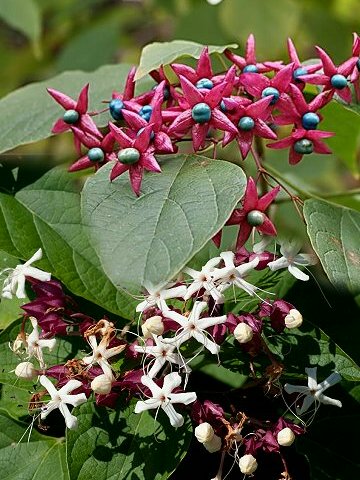
|
|
Harlequin Glorybower (Clerodendrum trichotomum).
Flowers and fruits
|
Harlequin Glorybower - Clerodendrum trichotomum
Clerodendrum trichotomum (harlequin glorybower, glorytree, peanut butter tree) is a species of flowering plant in the genus Clerodendrum. It is placed in the family Lamiaceae, or sometimes the Verbenaceae. It is native to China, Korea, Taiwan, Japan, and India.
Clerodendrum trichotomum is a coarse, sometimes unkempt, deciduous shrub or small tree that grows 10-20’ tall. It is most often seen as a suckering shrub. It must be trained to grow as a tree and is rarely seen growing in that form. As an ornamental, this shrub is perhaps best noted for its late summer flowers, showy fruit and malodorous foliage.
Tubular, fragrant, white flowers in long-peduncled cymes (to 6-9” across) bloom in the upper leaf axils from late summer into fall. The perfume is exotic and elusive. But there is even more than bloom and fragrance to this small tree since in late summer there are stunning fruits. The seed is a metallic
blue sapphire framed by a fleshy red-magenta calyx. And flowers and fruits can be found on the plant at the same time.
Opposite, toothed to entire, ovate, dark green leaves (to 5-8” long) produce no fall color and covered with a soft fuzz. When bruised, the leaves do produce a unique aroma reminiscent of peanut butter as memorialized by the sometimes used common name of peanut butter tree for this plant. Harlequin glorybower is a more frequently used common name.
Genus name Clerodendrum was named by Linnaeus in Species Plantarum in 1753. Clerodendrum comes from the Greek words kleros (fate) and dendron (tree), hence the infrequently used common name of fate tree.
It is cultivated for its fragrant flowers, autumn colour, and ornamental berries. It is hardy but requires a sheltered position. The variety C. trichotomum var. fargesii (Farges' harlequin glorybower) has gained the Royal Horticultural Society's Award of Garden Merit. It prefers full sun and moist well drained soil. It exhibits little winter interest so is best used in a mixed border. It grows 15 to 20 feet tall and is often multi-trunked but could be grown as a single trunked specimen if staked. It is the perfect size for today’s smaller gardens and ideal for container, or patio which is especially useful in colder climes as this is a warm temperate to subtropical plant.
Obviously, hummingbirds are attracted to it, hence the name hummingbird
bush. Strangely, though, they are attracted to the fragrant blooms in August and September and not the colorful red and blue seed
pods.
Clerodendrum trichotomum has varied medicinal properties.
In China parts of the plant are important for creating several herbal
medications. The leaves are mildly analgesic, antipruritic, hypotensive and sedative. They are used externally in the treatment of dermatitis and internally for the treatment of hypertension, rheumatoid arthritis, joint pain, numbness and paralysis. When used in a clinical trial of 171 people, the blood pressure of 81% of the people dropped significantly - this effect was reversed when the treatment was stopped. The plant is normally used in conjunction with Bidens bipinnata.
When used with the herb Siegesbeckia pubescens it is anti-inflammatory. The roots and leaves are antirheumatic and hypotensive. A decoction is used in the treatment of rheumatoid arthritis and hypertension.
The pounded seed is used to kill lice.
Source:
http://en.wikipedia.org/wiki/Clerodendrum_trichotomum
http://www.atreeaday.com/atreeaday/Clerodendron_trichotomum.html
http://www.missouribotanicalgarden.org/PlantFinder/
PlantFinderDetails.aspx?kempercode=b737
http://www.pfaf.org/user/Plant.aspx?LatinName=Clerodendrum+trichotomum
